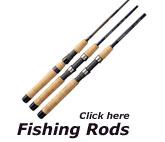In determining a fishing rod and reel one must consider the species you are fishing for along with the type of lure or live bait to be used. For instance your rod and reel set-up should match the fishing presentation. If you're pursuing panfish using light lures or small minnows your outfit should be lightweight for casting and detecting bites, not a heavy baitcaster for pike or bass. There are five main basic categories of fishing rod and reel combinations, and within each there are multiple sub-categories of specialty types of outfits used for specific fishing applications, for example Walleye fisherman use rod and reel set-ups for slip bobber, slip sinker, jigging and trolling. Bass fisherman carry pitchin', flippin', crank baiting, and soft plastics combo's. Muskie anglers have bucktail, jerk bait and top water outfits. In short, fishing rods and reels have come a long way over time, with new space age materials having been developed for rod construction making them longer and much lighter as well as reels with multiple ball bearings and one piece alloy and graphite frames.
This is the preferred set-up for the inexperienced angler. Spincasting outfits are excellent in teaching the beginning angler and children the mechanics of casting. The spin cast reel is mounted above the rod with the reel spool enclosed with a nose cone cover, this prevents line snarling and backlash's that are associated with bait casting reels. Casting is a simple task, the angler presses and holds down a button on the rear of the reel, this disengages the line pick-up pin, upon the forward cast the line comes off the spool. Once the crank handle is turned the pick-up pin is engaged retrieving the line on the spool.
Spincast reels have low gear ratios as a result of the size of the spool, which makes it difficult to fish lures that require a fast retrieve such as: inline spinners, spinner baits and buzz baits. When purchasing a spincast reel consider selecting models with anti reverse and smooth drag system versus the inexpensive all plastic models with sticky drags that result in broken line. For rods buy fiberglass their durable will hold up from abuse.
Fishing line is by far the utmost important fishing equipment component for anglers, as the line is the direct connection between the fisherman and the fish. Using the proper line in presenting lures or live bait, upon hooking a fish and landing the fish is the key to a successful catch. Yet many anglers are not aware about the new types of lines available today each with itís own special use and qualities including stretch, flexibility, knot strength, visibility, breaking strength, diameter and abrasion resistance.


Dennis Cummings, March 17, 2011
| Home |